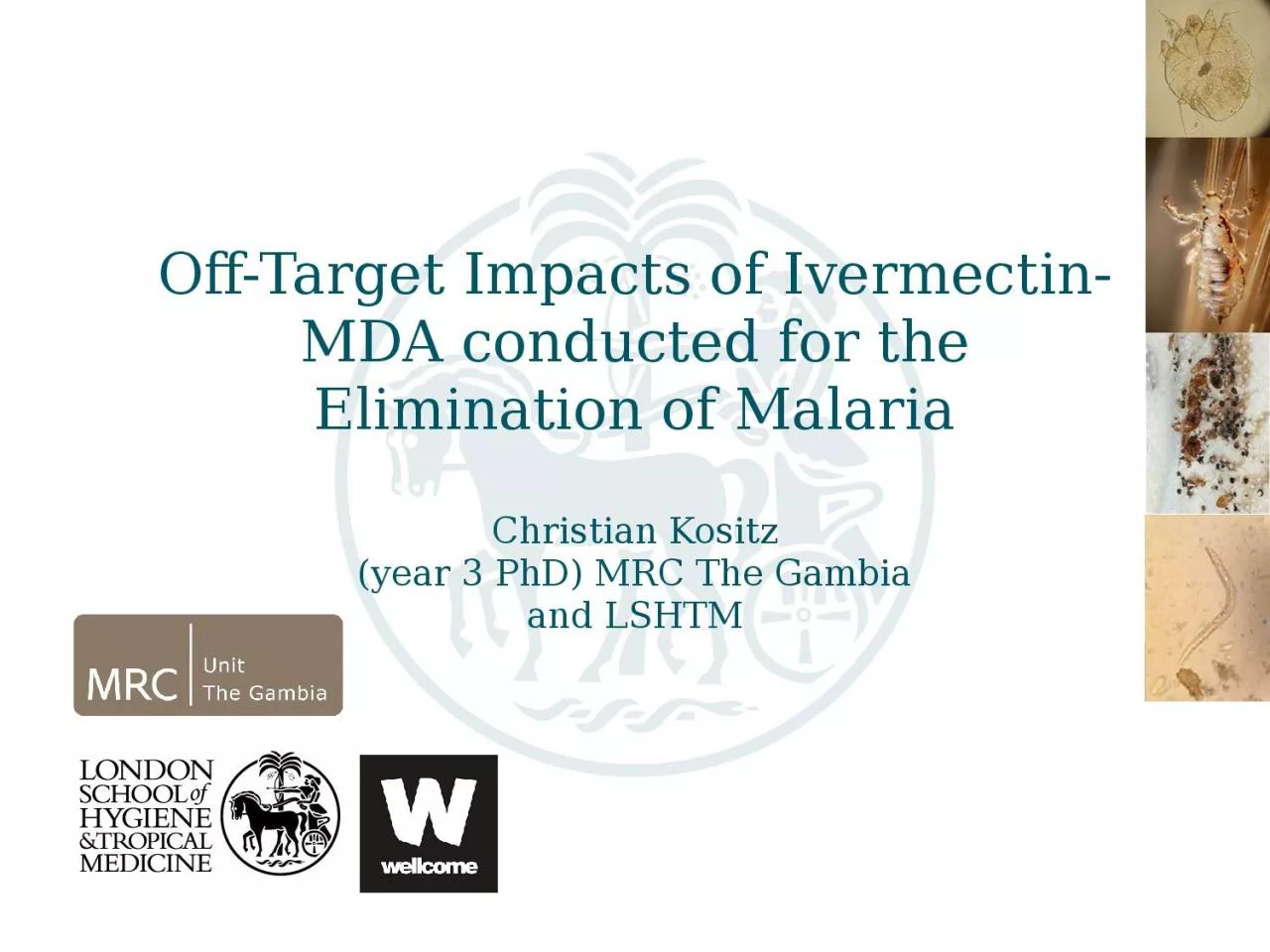

Christian Kositz year 3 PhD MRC The Gambia and LSHTM Background MASSIV Trial Eastern Gambia Mass drug administration for malaria dihydroartemisinpiperaquine and ID: 932311
Download Presentation The PPT/PDF document "Off-Target Impacts of Ivermectin-MDA con..." is the property of its rightful owner. Permission is granted to download and print the materials on this web site for personal, non-commercial use only, and to display it on your personal computer provided you do not modify the materials and that you retain all copyright notices contained in the materials. By downloading content from our website, you accept the terms of this agreement.
Slide1
Off-Target Impacts of Ivermectin-MDA conducted for the Elimination of MalariaChristian Kositz(year 3 PhD) MRC The Gambiaand LSHTM
Slide2Background – MASSIV Trial – Eastern GambiaMass drug administration for malaria (
dihydroartemisin-piperaquine) and malaria vector control (ivermectin) in 32
villages (= 32 clusters) with 16 per arm (intervention and control)Ivermectin300 mcg/kg/bodyweight
for 3 days per month for 3
months
(
July
– September)
weight ≤ 15 kg
Pregnancy or breast feeding
Slide3Why look at off target effects?Ivermectin is effective against many ectoparasites (scabies, headlice, bedbugs) and several soil-transmitted helminths (Ascaris lumbricoides (98-100%), especially Strongyloides stercoralis (83-96%), less against Trichuris trichiura (11-88%) or hookworms (0-33%)
Pre-2019 burden of these parasites (ecto- and entoparasites
) in Upper River Region in The Gambia was unknown or patchyHigher than usual dose of ivermectin and repeated doses
Effect of this intervention on some parasites is unclear (e.g. hookworms)
Slide4Existing evidence of ivermectin MDA for scabies
Lake SJ et al.
(2022)
Mass drug administration for the control of scabies: a systematic review and meta-analysis
Slide5Existing evidence of ivermectin MDA for Strongyloides stercoralis
Kearns TM, et al. (2017)
Strongyloides
seroprevalence
before
and after an ivermectin
mass
drug
administration
in a remote
Australian
Aboriginal community
.
Slide6Timeline3 Surveys for ectoparasites and soil transmitted helminths (STH)June 2019 before 2019 MASSIV MDA (July 15 to Sept 30) only ectoparasites (Spoilers: no bedbugs or headlice found)November 2019 after 2019 MASSIV MDA (scabies and STH)
November 2021 follow up (scabies and STH)originally planned for 2020
Slide7Methods: Sample size:Estimated 15% prevalence for each disease group30 children per cluster/village (32) => 960 children age 3 - 14 Simple randomization (~1300 children)Same children selected for 2019 surveysNew selection in 2021 (movement, change in age)
Ectoparasites:Physical examination for headlice Physical examination of sleeping quarters
Physical examination for scabies using the 2018 IACS criteria
Soil-transmitted helminthsStool collection from the participants (
almond
sized
sample)
mothers collected from their children
adolescents themselves (or under parent supervision)
In house qualitative PCR of the stool samples
Singleplex
for S. stercoralisMultiplex for A. lumbricoides, N. americanus, Ancylostoma duodenale, Trichuris trichiura
Slide8Results: Prevalence of Scabies
Scabies
Prevalence
N(%)
Agegroup
Jun-19
Nov-19
Nov-21
3 - 6
226/461 (49%)
175/387 (45.2%)
179/359 (49.8%)
7 – 10
160/393 (40.7%)
152/387 (39%)
168/356 (47.1%)
11 – 14
92/242 (38%)
92/278 (33.1%)
78/207 (37.6%)
Sex
Female
217/552 (39.3%)
205/535 (38.3%)
175/456 (38.4%)
Male
261/544 (47.9%)
214/517 (41.4%)
250/466 (53.6%)
Arm
Control
273/567 (48.2%)
237/576 (41.2%)
180/464 (38.8%)
Intervention
205/529 (38.8%)
182/476 (38.2%)
245/458 (53.2%)
OR (95%CI)
0.64 (0.43 - 0.95)
0.88 (0.66 – 1.8)
1.94 (1.1 – 3.43)
Total
478/1096 (43.6%)
419/1052 (39.8%)
425/922 (46.1%)
Slide9Results: Prevalence of Scabies
Slide10Results: STH
Nov-19
Participants
Strongyloides
Ascaris
Necator
STH total
Agegroup
Prevalence STH N (%)
3 – 6
356 (37.2%)
50 (14.04%)
12 (3.4%)
17 (4.8%)
73 (20.5%)
7 – 10
372 (38.8%)
57 (15.3%)
20 (5.4%)
16 (4.3%)
84 (22.6%)
11 – 14
230 (24%)
20 (8.7%)
7 (3%)
13 (5.7%)
36 (15.7%)
Sex
Female
480 (50.1%)
63 (13.1%)
18 (3.8%)
20 (4.2%)
93 (19%)
Male
478 (49.9%)
64 (13.3%)
21 (4.4%)
26 (5.4%)
100 (20.9%)
Arm
Control
518 (54.1%)
87 (16.9%)
22 (4.4%)
26 (5%)
121 (23.4%)
Intervention
440 (45.9%)
40 (9.1%)
17 (4%)
20 (4.6%)
72 (16.4%)
OR
0.39 (0.16 – 0.94)
0.91 (0.47 – 1.72)
0.85 (0.36 – 2.0)
0.62 (0.33 – 1.19)
Total
958
127 (13.3%)
39 (4.1%)
46 (4.8%)
193 (20.2%)
Slide11Explanations for Scabies resultsWithin study reservoirs not treated with ivermectin (children < 15kg, pregnant or breast feeding women), absent villagers (visiting, travelling, hiding, not participating)External reservoirs: schools, new inhabitantsIntervention coverage might be sufficient for malaria but insufficient for scabies
Slide12Explanations for STH resultsApparent effect on Strongyloides:Have we measured at the right time point?S. stercoralis prepatent period 2 – 4 weeks (up to 8)Larval stage “less susceptible” to ivermectin (rumour? data?)Follow up data from November 2021 outstanding (ETA 04/2022)
One single village strongly influenced the ivermectin effect (contained 20% of Strongyloides in the intervention arm) => underestimated effect
Other STH:Sample size too small?
N. americanus effect still unclear unfortunatelyNo apparent effect on A. lumbricoides
Slide13ConclusionNo effect on scabies seen;higher coverage neededaddition of treatment for non-eligible ivermectin groupsEvidence of an effect on Strongyloides
Ivermectin for malaria vector control is likely to have off target effects and studies should look out for them
Ectoparasites comparatively cheapSoil-transmitted helminths are more resource intensivePotential environmental impact
(dung beetles)
Potentially adds to cost-effectiveness of the intervention
Slide14AcknowledgementsFieldwork:Omar JallowDullo BaldehEbrima MannehMuhammed GissayMariama Drammeh
Franca Conradis-JansenWassa NjieDembo KM Fatty
Muhammed BaldehEdwin ArmitageAlagie Darboe
Labwork
:
Hristina
Vasileva
Joanna Houghton
James
Ashall
Logistics
:
Rasheed SalaudeenIkumapayi Usman Nurudeen
John Correa
Abdoulie
Sillah
Institutions and Funders:
Supervisors:
Michael Marks
John Bradley
Umberto D’Alessandro